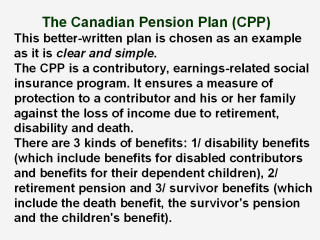| front |1 |2 |3 |4 |5 |6 |7 |8 |9 |10 |11 |12 |13 |14 |15 |16 |17 |review |
 |
The CPP operates throughout Canada, although
the province of Quebec has its own similar program, the Quebec Pension Plan.
The Canada Pension Plan and the Quebec Pension Plan work together to ensure
that all contributors are protected. Every person in Canada over the age of
18 who earns a salary must pay into the CPP. You and your employer each pay
half of the contributions. If you are self-employed, you pay both portions. You do not make contributions if you are receiving a CPP disability or retirement pension. At age 70, you stop contributing even if you have not stopped working. The amount you pay is based on your salary. If you are self-employed, it is based on your net business income (after expenses). You do not contribute on any other source of income, such as investment earnings. If, during a year, you contributed too much or earned less than a set minimum amount, you will receive a refund of contributions when you complete your income tax return. You only pay contributions on your annual earnings between the minimum and a set maximum level (these are called your "pensionable" earnings). The minimum level is frozen at $3,500 Canadian dollars. The maximum level is adjusted each January, based on increases in the average wage. Your contributions are used to determine if you or your family are eligible for a benefit, and to calculate the monthly amount. Both the length of time and the amount of earnings on which you contribute (up to the maximum each year) are factors. Normally, the more you earn and contribute to the CPP over the years, the higher the benefit will be, because you will have built up a lot of CPP pension credits. |